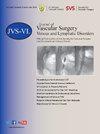A venous hemodynamic model and measurement of venous reflux in the lower limb during walking—Proof of concept
IF 2.8
2区 医学
Q2 PERIPHERAL VASCULAR DISEASE
Journal of vascular surgery. Venous and lymphatic disorders
Pub Date : 2025-03-20
DOI:10.1016/j.jvsv.2025.102236
引用次数: 0
Abstract
Objective
Air plethysmography (APG) is an established plethysmographic method of measuring leg volume changes in absolute units (mL or mL/s) during tiptoeing. However, tiptoe movements use different muscles from walking and the question of how physiological APG measurements during tiptoeing are has never been answered. The recent development of a commercially available wireless APG enables one to obtain measurements during walking. The aim of our pilot study was to (a) validate a venous hemodynamic model of blood volume changes in the leg during walking and (b) determine the magnitude of reflux per step in patients with venous reflux using this model.
Methods
A total of 20 limbs were included in this study. Ten patients with 10 limbs that had axial reflux in the deep veins on duplex scanning without any outflow obstruction or residual thrombosis on venography were selected. Standard measurements were initially made using tiptoeing as the form of exercise. Venous volume measurements made when walking was the exercise were volume on standing (V0) in milliliters, volume at steady state when walking (Vss) in milliliters, residual volume fraction during steady state as a percentage, ejection fraction (EF) as a percentage and inflow into the leg (I), which included reflux and arterial inflow in mL/step.
Results
There was an exponential reduction in volume during the first 7 to 9 steps, indicating a constant EF and supported the assumptions for the volume hemodynamic model. V0, EF, and I were higher in limbs with reflux compared with limbs without reflux by 67% (P < .007), 44% (P = .009), and 156% (P < .001) respectively.
Conclusions
The results of this pilot study indicate that the model and method used provide a practical noninvasive method of measuring reflux during walking. The increase in V0 and EF indicates a compensatory mechanism. This is the first time such a measurement has been possible because of the availability of wireless air plethysmography. It offers an opportunity for further studies to answer questions such as what the effect of iliac stenting or valvuloplasty are on reflux during walking.
行走时下肢静脉回流的静脉血流动力学模型和测量——概念验证。
目的:空气体积描记仪(APG)是一种以绝对单位(ml或ml/s)测量脚尖行走时腿部体积变化的方法。然而,踮起脚尖运动与走路使用不同的肌肉,而踮起脚尖时生理APG测量的问题从未得到回答。最近开发的一种商用无线APG使人们能够在行走时获得测量结果。我们初步研究的目的是(a)验证行走过程中腿部血容量变化的静脉血流动力学模型,(b)使用该模型确定静脉反流患者每一步的反流强度。方法:选取20只肢体进行研究。选择双相扫描有深静脉轴向反流且无流出静脉阻塞或静脉造影残余血栓形成的10例10肢患者。标准的测量最初是用脚尖走路作为一种锻炼方式。运动时进行的静脉体积测量包括站立体积(V0) (ml)、行走稳态体积(Vss) (ml)、稳态剩余体积分数(RVFss)百分比、射血分数(EF)百分比和腿部流入(I)(包括回流和动脉流入,单位为ml/步)。结果:在前7-9步,体积呈指数级减少,表明EF恒定,支持体积血流动力学模型的假设。有反流肢体的V0、EF和I分别比无反流肢体高67% (P < 0.007)、44% (P = 0.009)和156% (P < 0.001)。结论:这项初步研究的结果表明,所使用的模型和方法提供了一种实用的非侵入性方法来测量行走时的反流。V0和EF的增加表明了一种代偿机制。由于无线空气体积描记仪的可用性,这是第一次这样的测量成为可能。它为进一步研究提供了一个机会,以回答诸如髂支架植入或瓣膜成形术对行走时反流的影响等问题。
本文章由计算机程序翻译,如有差异,请以英文原文为准。
求助全文
约1分钟内获得全文
求助全文
来源期刊

Journal of vascular surgery. Venous and lymphatic disorders
SURGERYPERIPHERAL VASCULAR DISEASE&n-PERIPHERAL VASCULAR DISEASE
CiteScore
6.30
自引率
18.80%
发文量
328
审稿时长
71 days
期刊介绍:
Journal of Vascular Surgery: Venous and Lymphatic Disorders is one of a series of specialist journals launched by the Journal of Vascular Surgery. It aims to be the premier international Journal of medical, endovascular and surgical management of venous and lymphatic disorders. It publishes high quality clinical, research, case reports, techniques, and practice manuscripts related to all aspects of venous and lymphatic disorders, including malformations and wound care, with an emphasis on the practicing clinician. The journal seeks to provide novel and timely information to vascular surgeons, interventionalists, phlebologists, wound care specialists, and allied health professionals who treat patients presenting with vascular and lymphatic disorders. As the official publication of The Society for Vascular Surgery and the American Venous Forum, the Journal will publish, after peer review, selected papers presented at the annual meeting of these organizations and affiliated vascular societies, as well as original articles from members and non-members.
 求助内容:
求助内容: 应助结果提醒方式:
应助结果提醒方式:


